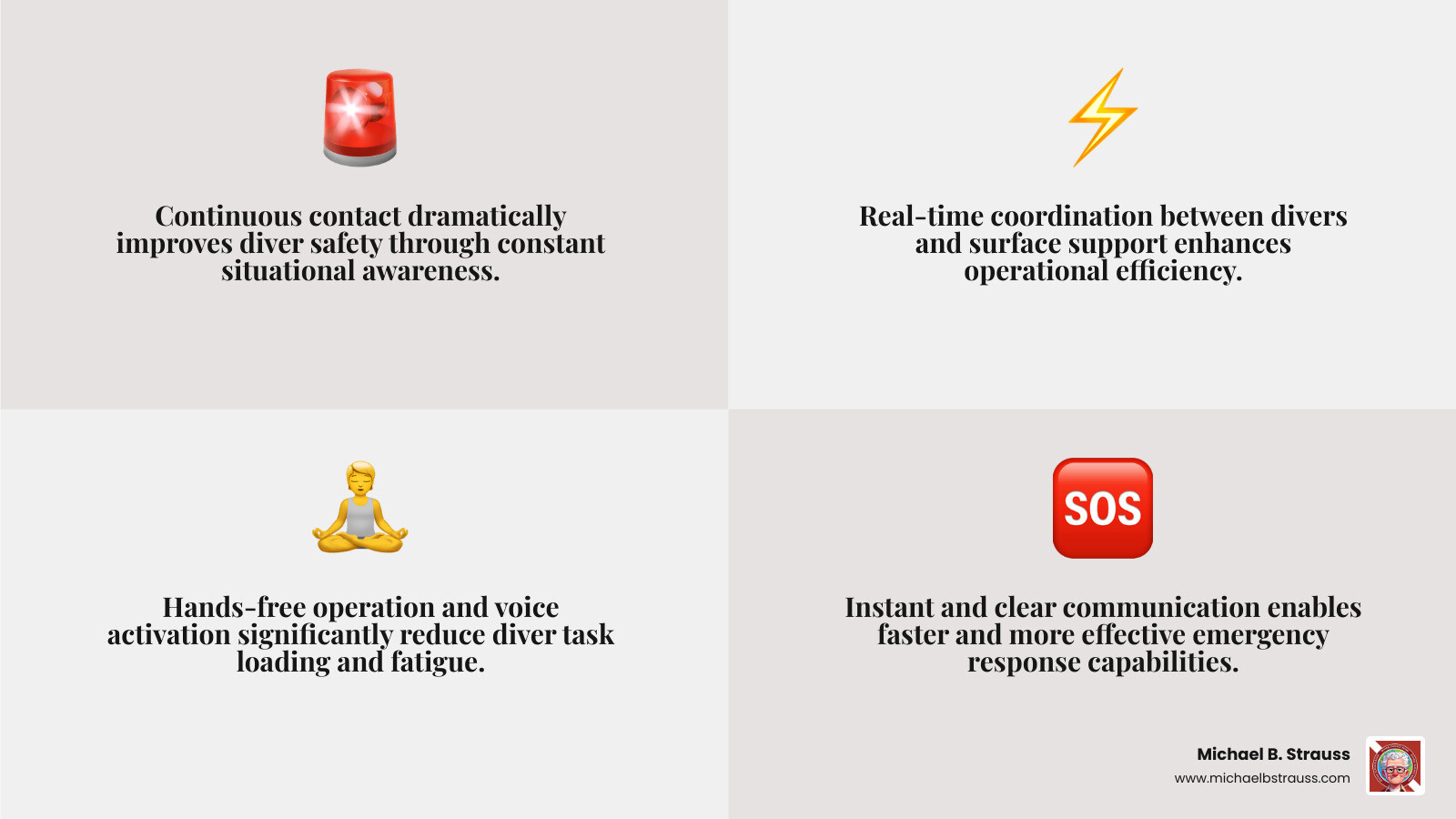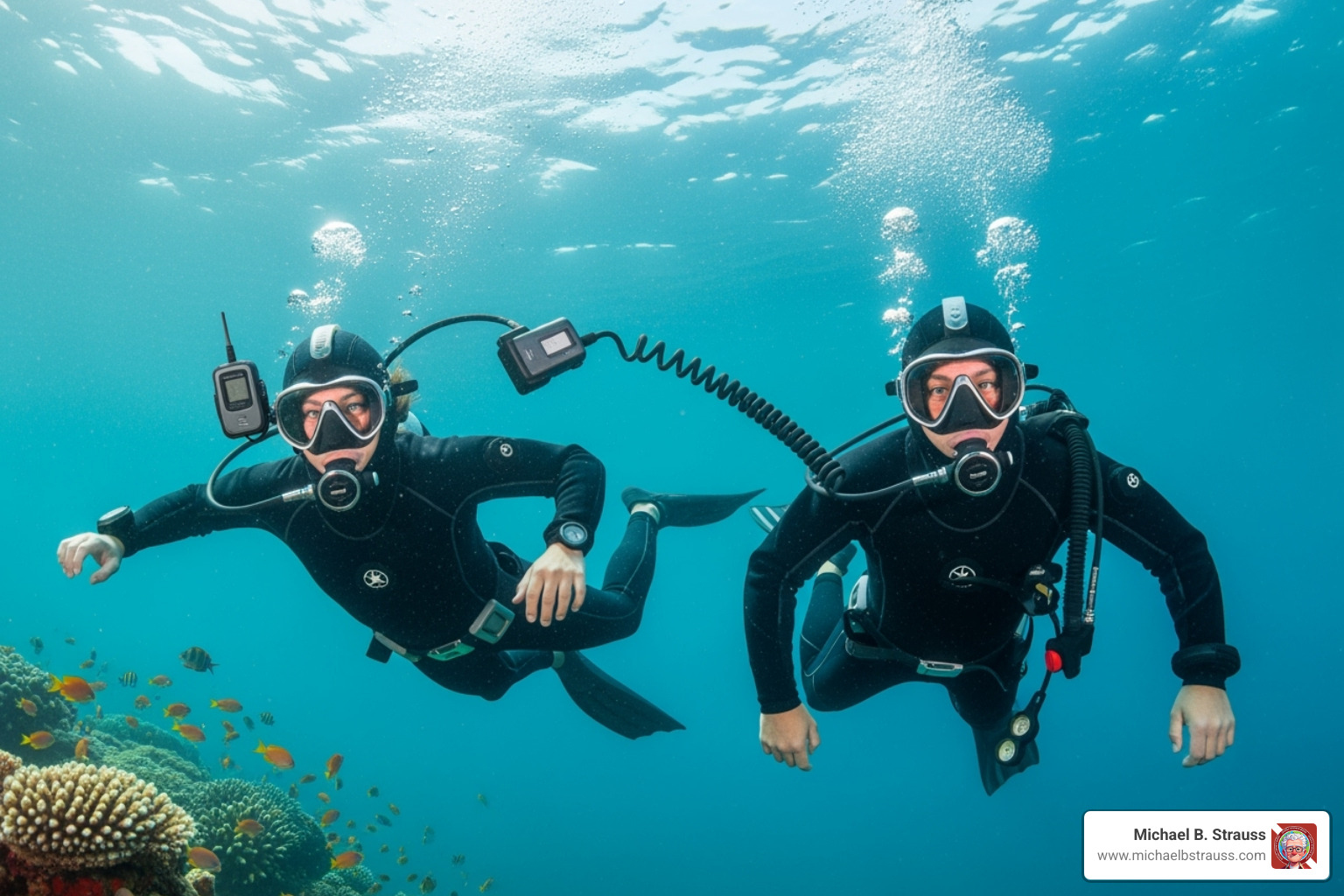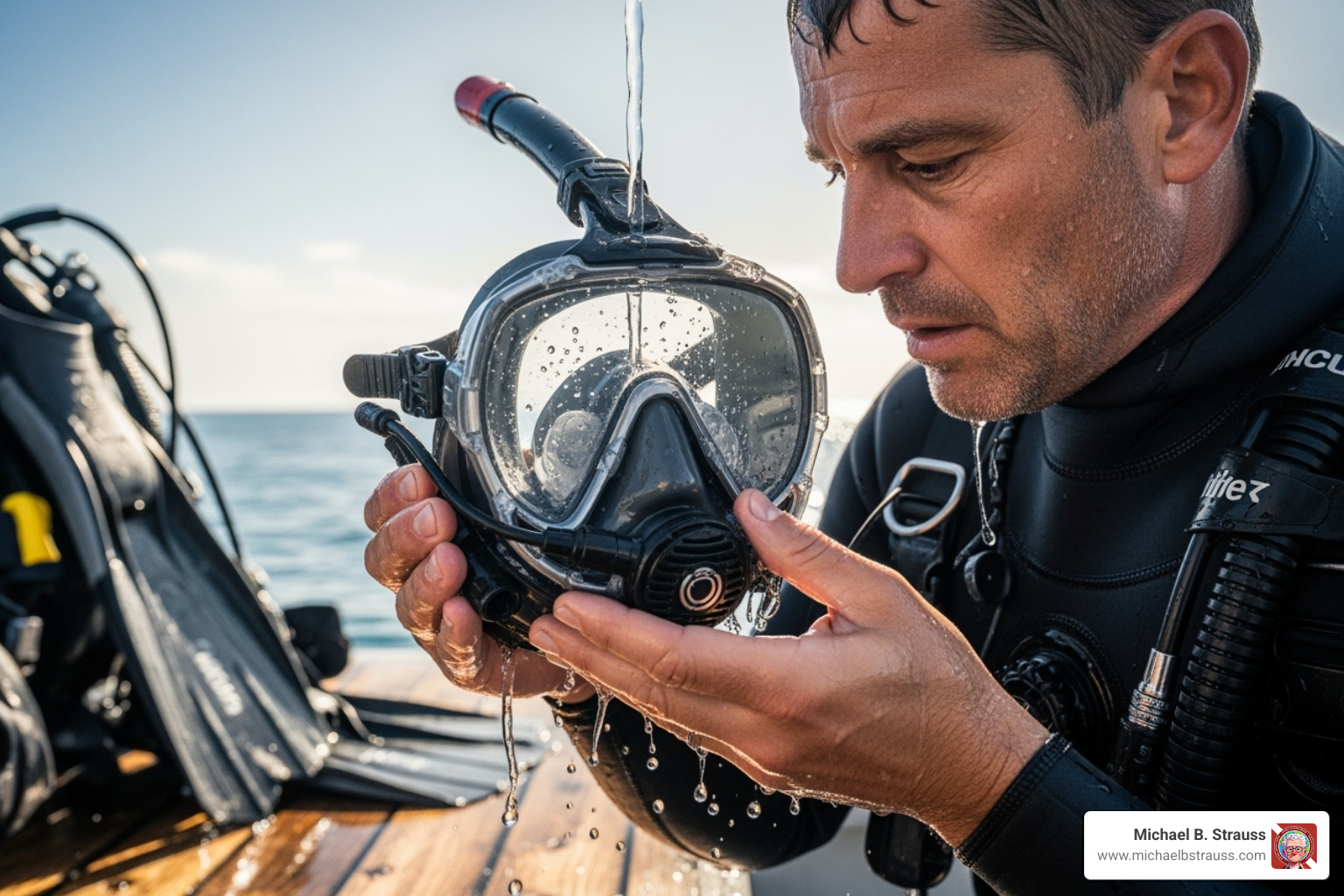Why Divers Are Talking: The Rise of Full Face Mask Communication
Full face mask communication systems are changing underwater operations by enabling divers to speak directly with their team and surface support. This technology moves beyond hand signals, offering critical safety and efficiency benefits for recreational and professional divers alike.
Key benefits include:
- Improved Safety & Coordination: Real-time voice contact improves situational awareness and teamwork, which is vital in low-visibility or complex scenarios. As one public safety diver noted, "Diving in horrible conditions with zero visibility, the voice in your ears is the only sense of security."
- Increased Comfort & Focus: By eliminating the need to bite a mouthpiece, these masks reduce jaw fatigue and allow for more natural, hands-free breathing. This lets divers focus on their tasks.
- Improved Protection: A full face mask shields the diver's face, offering protection from contaminated water in hazardous environments.
Systems work by integrating microphones and headphones into the mask, transmitting voice via ultrasonic waves (wireless) or a hardwired connection (tethered). Modern systems use Digital Signal Processing (DSP) to ensure clear speech, making them indispensable for public safety and technical diving where clear communication is non-negotiable.

Choosing the right system depends on your specific diving needs, but the impact is clear: full face mask communication allows dive teams to operate as a more cohesive, efficient, and safer unit.
A Guide to Full Face Mask Communication Systems
When you're exploring full face mask communication, you'll find yourself choosing between two main paths: wireless and tethered systems. Understanding these differences is about finding the right tool for your underwater mission.
Wireless vs. Tethered Systems: Which is Right for Your Dive?

The choice between wireless and tethered full face mask communication systems boils down to a trade-off between freedom of movement and absolute reliability.
Wireless Systems: The Freedom to Move
Wireless systems offer complete underwater mobility, using ultrasonic signals to transmit your voice. Systems like the OTS Buddy Phone D2 use Digital Signal Processing (DSP) to filter out noise and deliver clear speech. A transmitter/receiver on the mask sends signals through the water to other divers or a surface station.
However, this freedom comes with limitations. Turbidity, distance, and underwater obstacles can degrade or block the signal. The nominal range of 50 to 500 meters can shrink dramatically in poor conditions, and a clear line of sight is often crucial for a stable connection.
Tethered Systems: Rock-Solid Reliability
Tethered systems use a physical wire to connect the diver directly to the surface. This hardwired connection provides an incredibly dependable communication link. There is no interference, no signal degradation, and no uncertainty about whether your message was received.
The obvious trade-off is mobility, as you are physically tied to your communication point. This is less of a concern in commercial or contaminated water diving, where a tender is already managing a safety line. For these operations, the communication tether is simply part of the lifeline system, making it the preferred choice when reliability is paramount.
PTT vs. VOX: Understanding Microphone Activation
After choosing a connection type, you must decide how to activate your microphone: Push-to-Talk (PTT) or Voice-Activated (VOX).
Push-to-Talk (PTT): The Disciplined Approach
PTT systems require you to press a button to speak. This method is simple, prevents accidental transmissions, and keeps the communication channel clear of breathing sounds. It ensures all messages are intentional.
The main drawback is task loading. If both hands are busy, a diver must stop their work to find and press the PTT button. This can disrupt the flow of critical operations and impact efficiency, especially in high-stress situations.
Voice-Activated (VOX): The Hands-Free Solution
VOX systems automatically activate the microphone when you speak, offering a true hands-free experience. This is a game-changer for divers performing complex tasks.
Beyond convenience, VOX provides a significant safety benefit: it allows a surface tender to monitor the diver's breathing patterns. Labored or heavy breathing can be an early warning of stress, overexertion, or equipment issues. The downside is that VOX can be triggered by heavy breathing or other noises if not calibrated correctly.
Understanding how stress affects breathing and performance is a key part of dive safety. These topics are central to the science that keeps us safe underwater. You can explore more about these critical aspects at More info about diving science.
Key Features for Public Safety and Technical Diving
For professional diving, a full face mask communication system is a critical piece of safety equipment. When selecting gear for public safety, technical, or commercial use, consider these essential features:
Durability: The system must withstand harsh conditions, including freezing or contaminated water. Look for high-quality materials like EPDM rubber and polycarbonate visors and reliable watertight seals.
Surface Stations: A surface communication station acts as the operation's command center. Professional units can monitor and communicate with entire dive teams simultaneously and often include recording capabilities for post-dive analysis and training.
Multi-Diver Coordination: Advanced systems should support multiple divers without chaotic cross-talk, using channel separation or conference call features to keep teams informed.
Helmet Integration: For divers wearing protective helmets, the communication system must integrate seamlessly. Look for models specifically designed for helmet compatibility.
Simplicity Under Stress: In zero visibility or high-stress emergencies, equipment must be simple to operate. Controls should be manageable with thick gloves, and connections must be intuitive.
Decontamination Protocols: For contaminated water diving, all equipment must be easy to clean. Communication systems must survive thorough decontamination procedures without damaging sensitive electronics.
Clear Voice Transfer: In critical situations, clarity is key. Quality systems use features like specialized speech membranes or bone conduction technology to deliver easily understandable voice transmissions.
When selecting professional-grade full face mask communication systems, prioritize proven performance under pressure.
Top Masks for Full Face Mask Communication
Choosing the right mask means finding gear that combines superior breathing performance with robust communication technology. Here are some top models known for their reliability and features.
| Mask Model | Equalization Method | Comms Integration | Field of View | Key Feature |
|---|---|---|---|---|
| OTS Guardian FFM | Natural (various options) | Buddy Phone D2 (ultrasonic) | Excellent | Most popular among commercial divers in Canada. Top score for ease/dryness of breathing in head-down position. |
| Kirby Morgan M-48 SuperMask | Pinchers / Soft nose pocket | Optional hardwire comms | Strong performance | Favorite of test divers, super comfortable straps. |
| Interspiro Divator | (Various options) | Optional (HERMES-1) | Good | So quiet and easy-breathing. Uses bone conduction for excellent sound quality. |
| Ocean Reef Neptune III | (Various options) | Optional | Large viewing pane w/ curved, transparent edges | Strong performance across the board. |
OTS Guardian: A favorite in commercial diving, the Guardian is known for consistent performance in brutal conditions. It integrates seamlessly with the Buddy Phone D2 ultrasonic system and scores high for breathing ease, even at depth.
Kirby Morgan M-48 SuperMask: Praised by test divers for its comfortable straps and outstanding overall performance, the M-48 makes long dives more manageable. It supports hardwire communication options, ideal for technical and commercial work.
Interspiro Divator: Described as "so quiet and easy-breathing," this mask excels in breathing simulator tests. It's compatible with the HERMES-1 module, which uses bone conduction technology for excellent sound quality.
Ocean Reef Neptune III: This mask's large viewing pane with curved, transparent edges provides a panoramic field of view, which is crucial for situational awareness and detailed visual tasks.
These masks undergo rigorous ANSTI breathing machine testing to measure "work of breathing" and CO2 retention. The U.S. Navy limits re-inspired CO2 to 2%, while stricter European CE standards require 1%. Understanding these metrics is part of the science of diving safety. You can explore these crucial subjects further at More info about decompression science.
Maintaining Your Lifeline: Care, Training, and Final Thoughts
Your full face mask communication system is a lifeline. Proper care and maintenance are essential to ensure it functions reliably when you need it most.
Essential Maintenance for Your Full Face Mask Communication Gear

Adopt a consistent maintenance routine to protect your investment and your safety. Key steps include:
- Pre-Dive Checks: Before every dive, inspect cables for wear, ensure secure connections, and verify microphone/earphone placement.
- Battery Management: For wireless systems, check battery levels before every dive and always carry spares to avoid mid-dive communication loss.
- Post-Dive Cleaning: Rinse all components with fresh water after each dive, especially in saltwater, to prevent corrosion. For contaminated water dives, the system must be decontaminated carefully after diver decontamination.
- Seal Inspection: Regularly check the mask skirt and O-rings for tears, cracks, or deformities that could compromise the watertight seal.
- Professional Service: Adhere to manufacturer-recommended service intervals. Use certified technicians who have the specialized tools and knowledge to maintain your gear to factory standards.
- Proper Storage: Store your equipment in a cool, dry place away from direct sunlight, preferably in a designated protective case.
Consistent maintenance keeps your full face mask communication system ready for action. For more insights into equipment care, check out More info about diving resources.
Training and Overcoming Challenges
Advanced equipment requires proper training to be used safely and effectively. Comprehensive training is the foundation of successful underwater communication.
Specialty courses, such as the PADI Full Face Mask specialty, are essential. They cover unique safety considerations and skills like emergency mask doffing and donning, preventing task-loading in a crisis.
Dive teams must also establish and practice emergency procedures. Know what to do if your signal drops or a battery dies. Backup communication methods, like pre-defined rope pulls, are vital when electronics fail. Regular drills build muscle memory for high-stress situations.
Dr. Michael B. Strauss emphasizes that diving safety expertise comes from understanding both the equipment and the science behind it. His work highlights how knowledge of physiology and equipment limitations empowers divers to make better decisions. Full face mask communication systems add capability, but also complexity, making thorough training even more critical.
Investing in training and maintenance transforms your gear into a reliable lifeline, improving safety, team coordination, and mission success. To deepen your understanding of these principles, Learn more about the science of diving.
To deepen your understanding of the principles that keep divers safe, get your copy of Diving Science Revisited today. Buy the book here
DISCLAIMER: Articles are for "EDUCATIONAL PURPOSES ONLY", not to be considered advice or recommendations.






